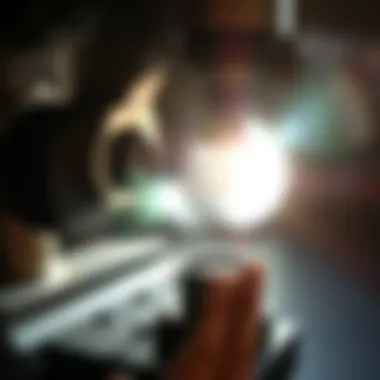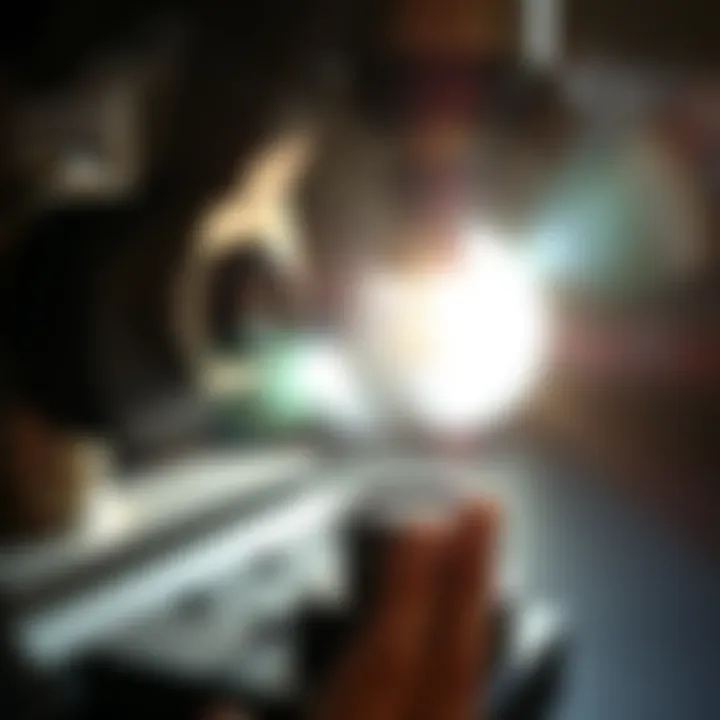Mastering the Refractometer Test in Gemology


Intro
Gemology, the study of gemstones, intertwines art and science to unveil the hidden beauty and value of various minerals. A critical tool in this pursuit is the refractometer—a device that measures how light bends as it enters a gemstone. This equipment doesn't just quantify numbers; it provides insight into a gemstone's identity and authenticity.
Understanding the refractometer test goes beyond just using the tool; it involves grasping the principles behind refractometry and its implications on gemstone evaluation. For novices and seasoned gem enthusiasts alike, this knowledge not only enhances appreciation of these natural wonders but also informs buying decisions.
Let’s dive in and uncover the layers of information required to effectively understand how the refractometer works and what the readings can tell us about the gems we cherish.
Prolusion to Refractometry
In the realm of gemology, the ability to accurately identify and assess gemstones is paramount. One critical tool that gemologists wield in this endeavor is the refractometer. This device is an instrument that measures the refractive index of materials, a significant property that aids in distinguishing between various gemstones. The importance of refractometry lies not just in its technical capabilities but also in its proven efficiency in streamlining the identification process for both seasoned professionals and enthusiastic collectors alike.
Understanding refractometry is vital, as it serves as a foundational element in both the study and trade of gemstones. By comprehending how light interacts with a gemstone’s surface and internal structure, gemologists can gather vital clues about the stone’s identity. Additionally, refractometry enhances the depth of analysis possible within gemology, making it an invaluable asset when faced with synthetic materials or imitations.
Moreover, the precision that comes with utilizing a refractometer allows for more informed decisions in purchasing and selling gemstones. For jewelry designers, having a firm grasp of refractometry enables them to create pieces that not only appeal aesthetically but also carry genuine quality and value.
Key aspects to consider in this introduction to refractometry include:
- Practicality – A refractometer can be a straightforward tool, yet it offers profound insights.
- Versatility – Its applications extend beyond mere gemstone identification, playing a role in mineralogy and material science.
- Educational Value – Learning about refractometry fosters a deeper understanding of the physical properties that define gems.
Together, these elements lay the groundwork for a comprehensive discussion on refractometry within this article. Understanding refractometry and its significance will pave the way for more detailed topics, from its principles to its practical applications in gemstone identification.
Defining Refractometry
Refractometry is essentially the science of measuring how light bends as it passes through different substances. This bending occurs due to a change in the speed of light when it transitions from air into another medium, like a gemstone. The degree to which light refracts is quantified as the refractive index (RI) of that material, and it forms the basis of refractometer readings.
In a refractometer, a small sample of the gemstone is placed on a glass plate. Light is then directed through this sample, and the instrument records the angle at which light is bent. Each gemstone exhibits a unique refractive index, thus enabling gemologists to classify and distinguish gems accurately. This is where the utility of refractometry becomes apparent—it’s a seemingly simple measurement that yields significant information.
Historical Context
The roots of refractometry can be traced back centuries to early studies in optics and light. While the ancient Greeks made initial observations on refraction, it wasn't until the 17th century that advances in lens design sparked serious interest in measuring refractive properties. The invention of the telescope and microscope propelled research into the behavior of light through various materials.
The development of the refractometer itself is attributed to this growing curiosity within the scientific community. In the late 19th century, the first dedicated refractometer was introduced, allowing gemologists to utilize these principles in gemstone identification.
As technology advanced, modern refractometers emerged, incorporating digital interfaces and automated readings, thus enhancing accuracy and ease of use. This historical evolution underscores not just the scientific significance of refractometry, but also its practical applications in gemology today.
Principles of Refractometry
In gemology, understanding refractometry is like having the right compass in uncharted waters. This principle is essential for gemstone identification as it provides a systematic way to determine a gemstone's refractive index. The refractive index is a numerical value that describes how light interacts with a substance, offering insights that are crucial in distinguishing one gem from another. This section examines the fundamental aspects of refractometry, shedding light on its significance and implications in the art and science of gemology.
Light Refraction Explained
Light refraction occurs when light passes from one medium to another, like air to water. This bending of light happens because it travels at different speeds in different materials. Consider how a straw appears bent when placed in a glass of water; it’s a straightforward illustration of refraction. In our case, when light meets a gemstone, it bends depending on the material's properties. Each gem refracts light uniquely, and this variance directly informs the stone's identity.
Refraction is measured by something called the angle of incidence and angle of refraction. The laws of Snell dictate that the ratio of the sine of these angles is equal to the ratio of the speeds of light in both media. In gemology, this principle can be practically applied using a refractometer. When light enters a gemstone, it refracts, and by analyzing the angle of light, gemologists can determine the refractive index.
Refractive Index and Its Importance
The refractive index is not merely a number; it's a vital piece of the puzzle in gem identification. Each type of gemstone has a specific refractive index value that reflects its internal structure and composition. This value can range widely; for example, quartz has a refractive index of about 1.54, whereas diamonds show a higher figure around 2.42.
Understanding the refractive index helps gemologists achieve several important tasks:
- Identification: Differentiating real gems from imitations.
- Quality Assessment: High-quality stones often exhibit a consistent refractive index, which can be a hallmark of authenticity.
- Certifying Stones: For those involved in trading or selling, a precise refractive index is critical for certification processes.
"The beauty of a gemstone often shines brightest when its true identity is revealed through scientific methods."
In addition to identification, refractive index readings can help in assessing how light interacts with the gemstone. This is particularly relevant for collectors and gem enthusiasts who want to understand the visual properties that make a gem appealing. As such, mastering refractometry is an integral skill for anyone serious about gems.
The Refractometer: An Overview


The refractometer serves as a crucial tool in the field of gemology, shedding light on the invisible properties of gemstones. This instrument allows gemologists to discern and analyze the refractive index of various gems, aiding in their identification and authenticity verification. By examining how light interacts with different materials, the refractometer provides insights into a gemstone's unique characteristics, thus contributing significantly to the overall understanding of gems.
A refractometer's importance lies not only in its functionality but also in the precision it brings to gemstone analysis. Gem enthusiasts, traders, and researchers rely on refractometers to make informed decisions. With a wide range of types available, selecting the right refractometer can greatly enhance both the accuracy and reliability of gemstone assessments.
Types of Refractometers
When exploring the realm of refractometers, it's vital to understand the distinct types available. Each model has its unique tailored use, characteristics, and benefits, contributing differently to the understanding of gemstones.
Abbe Refractometer
The Abbe refractometer is a stalwart of gemological science, widely known for its accuracy in measuring refractive indices. This instrument is particularly favored for its optical design which enables a clear view of the refractive index over a broad range. Gemologists appreciate how quickly they can obtain measurements, making it a beneficial choice in labs and educational settings.
A unique feature of the Abbe refractometer is its use of a light source and prism construction. By allowing light to pass through a sample placed on the prism, it generates a reading of the refractive index. This design is advantageous due to its high precision, although the device does require a careful setup and calibration for optimal results.
Gem Refractometer
The Gem refractometer, often called a handheld or portable refractometer, brings a different flavor to gemology. Its accessible design makes it a popular choice among gem hunters and jewelers alike who need quick measurements in the field. This type offers simplicity without sacrificing reliability, which can be crucial when identifying gemstones in various environments.
What sets the Gem refractometer apart is its specific focus on gemstones, which allows gemologists to make swift assessments. While it's convenient, its main drawback lies in limited capabilities compared to the more sophisticated Abbe refractometer; it might not provide the same level of precision in certain cases.
Digital Refractometer
Digital refractometers represent a contemporary evolution of this essential tool. Known for their user-friendly interfaces and enhanced accuracy, they can calculate refractive indices quickly and display results on an easy-to-read screen. This feature allows gemologists to obtain results without the need for extensive manual calculations, helping to minimize human error.
The unique advantage of digital refractometers is their ability to store multiple readings, which can streamline processes in gemological research or commercial settings. However, they often come at a higher price point than traditional models, which may not suit every budget. Nonetheless, for professionals aiming for precision and efficiency, the investment can be well worth it.
How to Use a Refractometer
Utilizing a refractometer requires a methodical approach to ensure accurate readings. Here are several crucial steps for their operation:
- Calibration: Always calibrate your refractometer before use, often with a distilled water sample.
- Sample Placement: Place a small droplet of the gemstone or liquid on the prism.
- Observation: Look through the eyepiece and observe the division line between light and dark zones to read the refractive index.
- Recording Data: Write down or save the reading for further analysis.
In sum, every type of refractometer contributes distinctively to the gemological process, combining to facilitate a deeper understanding of precious stones today. Understanding how each works can empower gem enthusiasts and professionals alike, allowing them to navigate the intricate world of gemstones with greater confidence.
Applying Refractometry in Gemstone Identification
Refractometry acts as a cornerstone in the world of gemology, serving a pivotal role in identifying gemstones. It provides insights that are often invisible to the naked eye, forming a linchpin of both quality assessment and authenticity verification. Gem enthusiasts and professionals alike turn to this method not merely as a means to separate glimmering stones from mere glass, but as a way to delve deeper into the unique properties that define a gem. Knowing how to perform a refractometer test can make the difference between an informed purchase and a costly mistake.
In essence, refractometry measures how light bends as it passes through a gemstone, which is determined by the stone's refractive index. Variations in refractive indices can lead to the correct identification of gemstones, isolating them from cheaper imitations. This ability to differentiate based on optical qualities enhances market confidence among traders and collectors. The specific nuances of gemstone identification utilizing refractometry can highlight various factors, such as clarity, color saturation, and even the internal structure of the gem. These aspects not only enrich a gem's appeal but also its value.
Furthermore, applying refractometry streamlines the gemstone assessment process. With a refractometer, gemologists can quickly generate precise data. This feature is particularly beneficial in busy trading environments where time is of the essence.
"In the fast-paced world of gemstone trading, the quicker you can authenticate a gem, the more reliable your reputation will be." – Anonymous
Identifying Gemstones through Refractive Index
The refractive index, often abbreviated as RI, is not just a number; it is a key that opens the door to understanding the individual identity of gemstones. Each gem has its own unique RI, a fingerprint of sorts, that distinguishes it from others. For example, diamonds have a high refractive index of about 2.42, while quartz rests around 1.54. This critical piece of data can be rapidly assessed using a refractometer, allowing gemologists to determine which type of gemstone is being examined within moments.
Moreover, the interpretation of RI readings goes beyond simple identification. It assists in recognizing whether a gemstone has been treated or modified. Anomalies in the expected RI can hint at treatments often employed to enhance a gemstone's aesthetics. This examination becomes vital for professionals involved in trading or manufacturing.
Combining Refractometry with Other Techniques
Combining refractometry with other analytical methods amplifies its effectiveness in gemstone identification. Two prominent techniques that work hand in hand with refractometry are spectroscopy and luster testing.
Spectroscopy
Spectroscopy focuses on the interaction between electromagnetic radiation and the gemstone. By analyzing the light absorbed, emitted, or scattered by a sample, gemologists can determine its mineralogical properties. This approach stands out because it reveals the composition of a gemstone at a molecular level, highlighting impurities or unique elements that may not be visible through refractometry alone.
The key characteristic of spectroscopy is its ability to detect subtle differences between similar gemstones. This becomes particularly advantageous in scenarios where refractometry readings are inconclusive. However, spectroscopy comes with a minor downside: it often requires specialized equipment and skill, so it might not be as readily accessible for every enthusiast or trader.
Luster Testing


Luster testing, on the other hand, investigates how a gemstone reflects light, categorized as metallic, glassy, silky, and more. This method offers additional layers of information, complementing the data obtained from refractometry. By blending luster observations with refractive index readings, gemologists gain greater insights into the purity and quality of a stone.
A unique feature of luster testing is its simplicity. While refractometry demands particular tools and conditions, evaluating luster can often be done with minimal equipment. This accessibility can make luster testing a popular choice among gem enthusiasts looking to gain insights into their specimens. Still, it’s important to remember that luster can be subjective, influenced by personal perceptions or environmental conditions.
In summary, the meld of refractometry, spectroscopy, and luster testing crafts a comprehensive approach to gemstone identification. Each technique plays its part in revealing hidden truths of gemstones, ensuring that gem aficionados are equipped with deep knowledge to navigate the vast and often complicated gem market.
Factors Influencing Refractive Index Readings
The refractive index of a gemstone is not just a static number; it is a reflection of multiple factors. To get a clear picture when using a refractometer, it's essential to acknowledge the elements influencing refractive index readings. Understanding these factors not only sharpens our accuracy in identifying gems but also broadens our appreciation for the complexities of gemology. Misinterpretations due to these influences can lead to incorrect conclusions, making it paramount for enthusiasts and professionals alike to be aware of their significance.
Temperature Effects
Temperature plays a crucial role in refractive index readings. As temperature rises, the energy within the gemstone increases, causing its atoms to vibrate more vigorously. This alteration can lead to variations in how light travels through the stone. For instance, a gemstone read at a warmer temperature may present a lower refractive index compared to the same stone measured at cooler temperatures. Consequently, it is vital to ensure that both the refractometer and the gemstone are acclimatized to a consistent temperature before taking measurements.
- Why Temperature Matters:
- Inconsistent temperature can cause fluctuations in readings.
- Identifying gemstones requires a controlled environment to yield accurate results.
Given these nuances, gemologists often recommend measuring stones in a temperature-stable venue, ideally around room temperature. Many prefer conducting tests at ambient levels to minimize discrepancies in their findings.
Crystal Structure and Its Impact
The crystal structure of gemstones inherently affects their refractive indices. Each mineral has its unique arrangement of atoms and molecules, leading to variations in optical properties. For example, the crystal lattice of quartz differs significantly from that of diamond. This structural distinction results in diverse ways that light behaves when it enters and exits these gems. In practical terms, this means that gemstones with complex arrangements can yield erratic refractive index results if not accounted for during analysis.
- How Crystal Structure Influences Refractive Index:
- Anisotropic vs. Isotropic:
- Impurities and Defects:
- Anisotropic crystals, like tourmaline, have different refractive indices based on direction; thus, variations in measurement can occur.
- Isotropic crystals, such as diamonds, present a uniform refractive index across the entire gem.
- Crystal defects or additional elements can skew readings, emphasizing the importance of having a clean sample for analysis.
In summary, recognizing the interplay between temperature and crystal structure is integral in gemology. These factors directly influence how stones are assessed and identified. A keen eye on these subtleties can save gem traders crucial time and resources, delivering the authenticity that customers expect in a market filled with imitations. Ultimately, gem enthusiasts who grasp these underlying principles will find themselves much better equipped to navigate the intricate world of gemstones.
Challenges in Refractometry
Refractometry, while a pivotal aspect of gemology, isn't without its bumps in the road. Understanding the nuances of this measurement technique can distinguish a knowledgeable gemologist from a novice. The challenges faced in refractometry can affect the accuracy of a reading, leading to potential misidentifications that could be costly or misinformative. This section delves into two significant challenges: common errors in measurement and dealing with impurities in samples. Both issues underscore the importance of diligence and attention to detail in this field.
Common Errors in Measurement
Even seasoned professionals can trip over common pitfalls when using a refractometer. Accuracy is key in refractometry, as gem identification can pivot on a decimal point. Here are some typical errors that can arise during measurements:
- Calibration Mistakes: A refractometer requires proper calibration before use. If it has not been calibrated with the appropriate standard, even minor discrepancies can lead to significant errors in readings.
- Incomplete Sample Coverage: When placing a gemstone on the refractometer, ensure that it fully covers the light path. Missing even a smidgen can throw off the entire measurement.
- Environmental Factors: Temperature and humidity can affect readings. Failing to control these factors often leads to unreliable results. For instance, a reading taken in a hot environment may differ from one conducted in cooler conditions.
- Rushed Measurements: It's tempting—especially in busy environments—to hurry through the testing process. But speed can compromise accuracy. Take the time to ensure thorough measurements to prevent doubt later.
A careful approach sums it up like this: every step in the measurement process matters. Think like a meticulous chef preparing a complex dish; missing an ingredient could spoil the whole meal.
Dealing with Impurities in Samples
Impurities in gemstones present yet another hurdle in refractometry. These can obscure the true refractive index and create misdiagnoses. Below are types of impurities that can affect readings:
- Natural Inclusions: Many gemstones come with inclusions—tiny imperfections that occur naturally. These can include gas bubbles or other minerals, disrupting light's path and altering refractive index readings.
- Surface Contaminants: Anything from dust to oils from fingers can create a film over the gemstone, skewing the measurement. Always ensure that the sample is cleaned thoroughly before taking readings.
- Synthetic Alterations: Increasingly, synthetic gemstones are hitting the market. They can sometimes exhibit a completely different refractive index than their natural counterparts, which can lead to classifications errors if evaluators are unaware of a stone’s origin.
To nip these issues in the bud, consider the following strategies to ensure the integrity of your readings:
- Thoroughly clean the gemstone prior to measurement, removing any dust or oils.
- Be aware of the stone's characteristics, like its known inclusions, to adjust your interpretation of the data accordingly.
"Measurements can be misguiding when impurities dance with light, but clarity shines when diligence is prioritized."
With vigilance and care in measurement processes, these challenges can be overcome, leading to accurate gemological assessments that can hold up in a court of scrutiny.


The Role of Refractometry in Gemstone Certification
In the world of gemstones, certification holds utmost significance. It not only provides authenticity but also assures buyers of the quality of their purchase. Here, refractometry plays a pivotal role, acting as a reliable tool for gemologists in determining the refractive index of a gemstone. Understanding this relationship between refractometry and gemstone certification offers insight into the processes that protect both the buyer and the seller.
The refractive index, an essential property of gemstones, helps to differentiate between similar-looking stones. Within the certification process, it ensures that each gem is correctly identified and valued. A refractometer's precise readings play a significant role in a gemological laboratory, where professionals analyze samples meticulously.
Moreover, using the refractometer enhances transparency. When a gemstone is tested and certified, the results are documented. This provides an additional layer of trust for both gem traders and consumers. A certified gemstone typically carries a report from an accredited laboratory, and the refractive index is usually listed on this document.
"Accurate refractive index readings can be the difference between a valuable gem and a mere imitation."
Thus, refractometry does more than just measure a gem's optical properties; it contributes to the integrity of gemstone trading. A transparent process fosters confidence and helps ensure that buyers are not just tossing their money to the wind.
Importance for Gem Traders
For gem traders, calibration of the refractometer and understanding its output is crucial. First and foremost, accuracy in measurements is the cornerstone of a good reputation. When traders can guarantee the authenticity of their gemstones, they establish themselves in a competitive marketplace.
Traders often encounter synthetic and treated stones which may look strikingly similar to natural gems. In such cases, the refractive index serves as a determiner, helping to distinguish the genuine article from fakes. Knowing the refractive indices of popular gemstones like diamonds and sapphires can offer a significant advantage to a trader.
Some gemstones may sit closely in terms of refraction; however, specific values or behaviors under polarized light confirm their identity. Reliable readings aid in making informed decisions about pricing and marketing. Keeping a jewel’s refractive index in mind not only arms traders with knowledge but also enhances their negotiation skills, as they can present documented and verified information confidently.
Standards in Gem Testing
Standards in gem testing are indispensable, especially with the variety of gemstones flooding the market. Regulatory bodies, such as the International Gemological Institute (IGI), set guidelines that dictate how refractometry should be approached in gem testing practices. Adherence to these standards ensures consistency and further cements the legitimacy of gemstone certifications.
- Reference Tables: Reputable laboratories keep extensive tables of known refractive indices for a multitude of gemstones. This serves as a baseline for comparison during testing.
- Calibration Protocols: Frequent calibration of refractometers is essential to ensure accurate readings. Certified gemological institutions carry out regular maintenance and recalibrations to maintain high standards.
- Methodological Rigor: The testing methods need to be standardized, including how the refractometer is used. This may extend to environmental conditions like temperature, which can affect measurements.
By adhering to rigorous standards, gem testing providers play a crucial part in maintaining the trust and quality assurance that consumers expect. A reputable gemstone certification not only includes visual identification and weight assessment but also incorporates unequivocal refractive index data to underpin its findings.
Future Trends in Refractometry
The world of gemology is evolving at a breathtaking pace, driven largely by advances in technology and innovative methodologies. Understanding future trends in refractometry is critical for gemstone enthusiasts, collectors, jewelry designers, and geology aficionados who wish to stay ahead of the curve. As the tools and techniques associated with refractometry continue to develop, they promise not only to enhance the accuracy of gemstone identification but also to expand the overall knowledge surrounding these precious materials. Understanding this evolution can aid professionals in making informed decisions, ensuring that their practices remain relevant and effective.
Technological Advancements
Recent technological breakthroughs are reshaping how refractometers function and are utilized, making it important to take note of these advancements. Here are some noteworthy points to consider:
- Miniaturization: New designs focus on creating more compact, portable refractometers that can be easily used on-site at gem trade shows or in remote locations where convenience is essential. This mobility allows for instant readings without the need for extensive laboratory setups.
- Digital Integration: With the rise of smart technologies, many modern refractometers now integrate digital features for data management. These devices can easily interface with smartphones and computers, allowing gemologists to store readings, compare results, and access gemstone databases instantaneously. Such features not only enhance productivity but also minimize human error in data logging.
- Advanced Sensors: Contemporary refractometers are increasingly being equipped with advanced optical sensors that improve measurement accuracy. For instance, sensors that automatically adjust to varying temperatures or ambient light can yield more reliable results, leading to better gemstone evaluations.
- AI and Machine Learning: Integrating artificial intelligence into refractometry could revolutionize how gemstones are classified. By analyzing vast amounts of refractive index data from various gems, AI models can assist gemologists in making quicker and more accurate identifications, potentially unveiling patterns that may not be evident through traditional methods.
Emerging Techniques
Aside from technology, a few emerging methodologies are marking their footprint in the field of refractometry and gemstone studies. Notably, these techniques push boundaries and hold the potential for wider applications:
- Spectroscopic Refractometry: This method combines refractometry with spectroscopy, allowing for more comprehensive material characterization. By analyzing the spectrum of light that a gemstone absorbs or reflects, gemologists can gain insights not solely limited to refractive indices, which can elevate gemstone classification.
- Nano-refractometry: Experimental techniques that utilize nanotechnology for refractometry are beginning to emerge. These methods can discern differences at the nano-level that traditional refractometers may overlook. Such precision could be pivotal for high-end gemstones or those that carry an exorbitant price tag where detail matters most.
- Multimodal Analysis: This approach integrates various gemological tests like luminescence or hardness factors with refractometry to provide a well-rounded assessment of a gemstone. By utilizing a combination of methods, gemologists can cross-check findings, thereby increasing confidence in their results.
"The future of refractometry is not merely about perfection in measurement, but the integration of diverse methodologies to form a richer understanding of gemstones and their properties."
As refractometry continues to advance, those engaged in gemstone study must remain agile and adaptive, embracing both the tools and methods that will define the future of gemology. Stay tuned for further developments that can potentially reshape the way gemstones are evaluated, traded, and cherished.
End
The conclusion ties together the various threads of refractometry in gemology, allowing both seasoned professionals and those new to the field to appreciate the vital role this technique plays. Understanding refractometry doesn’t just scratch the surface of have a keen eye for gemstones; it dives into the nuances that can make or break a gemstone's evaluation.
Summarizing Key Insights
At the heart of refractometer testing is the refractive index, a measurement that provides insights into a gemstone’s identity. Here are some key points to remember:
- Refractive Index Relevance: Knowing a gem's refractive index can often be the key to distinguishing it from a similar-looking impostor.
- Combination Techniques: Utilizing refractometry alongside other methods like spectroscopy ensures a more accurate identification.@
- Measurement Challenges: Gem professionals must be aware of temperature influences and the effects of impurities, as they can skew the results.
Each point above underscores how essential this method is for anyone serious about gemology. Without a solid grasp of refractometry, one might find themselves lost in the glittering sea of gemstones, unable to reliably identify or value them.
The Continuing Relevance of Refractometry
As the field of gemology continues to evolve, the relevance of refractometry remains steadfast. New technologies and techniques delving into the microscopic world of gemstones are set to enhance what we know about light interaction and refractive index. Here’s why refractometry will continue to hold its ground:
- Technological Integration: Modern refractometers with digital displays and built-in databases can provide instant identification assistance, making them invaluable tools for gem traders and collectors alike.
- Educational Significance: Teaching future generations about the refractive index instills a more profound understanding of gem characteristics, ensuring that knowledge in this area endures.
- Market Demand: As consumers increasingly seek authenticity in gemstones, the demand for reliable identification methods has skyrocketed. Continuing to rely on refractometry helps meet this demand.
In summary, the conclusion of this discussion on refractometry emphasizes not only the historical significance but also its practical application today. A strong foundational knowledge of refractometry enriches gemological expertise, paving the way for future advancements in the field.







